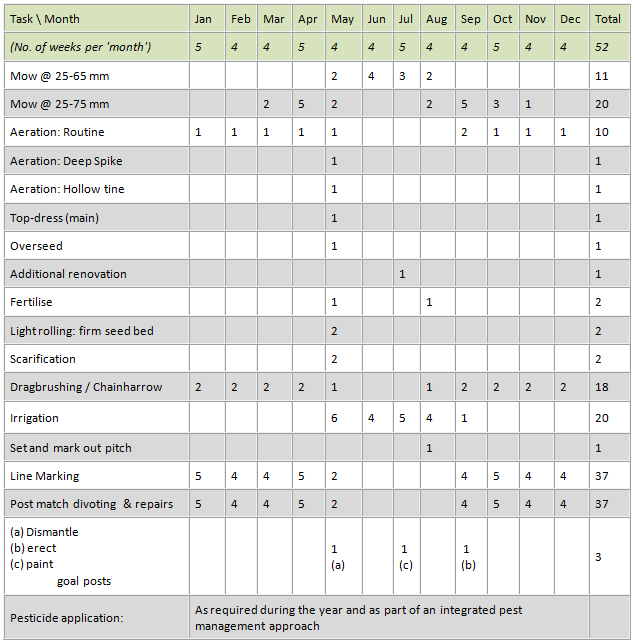The estimated number of occasions for which each task is planned to be carried out can be presented in the form of a maintenance calendar.
The total number of actual operations will primarily depend upon the standard to be achieved. Other factors such as prevailing weather conditions, as well as the geographic location of the rugby pitch and the rootzone composition will also have an influence.
Maintenance calendars can provide a very useful means for forward planning and the information can be converted into a staff profile, indicating workload levels, material requirements or budget flow.
The 'Months' in the Table are given as 4 or 5 week periods for convenience; this still adds up to 13 weeks per quarter. There is no reason why, for example, the January month is given as 5 weeks, so long as each quarterly block is made up of one 5 week period and the other two are 4 week periods, thus giving 13 weeks for each quarter.
It is useful to have April as a 5 week period as it gives some more leeway in planning, although this is probably arbitrary.
Each month could also be the exact number of days in a calendar month. Whichever system works for the user, then this is the one which should be adopted.
This example maintenance calendar is indicative of the work that may typically be undertaken on a rugby pitch. The quality of workmanship has a significant bearing on the ability to produce a good quality rugby facility.

Download a word version so you can edit it to suit your own requirements
Other operations which could also be listed include leaf removal, pitch sweeping for presentation purposes etc.
Note:
As with many operations, the weather will have a significant impact on what is required and when it can be carried out.
Aeration
Due to local conditions, it may be inappropriate to use an aerator over the autumn / winter period. A more effective approach may be to vertidrain in the early autumn and then again at renovation time.
It should be noted that the use of a tractor-mounted aerator on a regular basis may actually prove detrimental to the quality of a pitch.
Light Rolling
This will depend how well the renovated areas have already been firmed within the course of the renovation itself.
Scarification / Chain Harrowing
It may be appropriate just to turn chain harrow tines to point downwards to undertake a comparable operation.
Mowing
This will need to take place even when leaf growth is slow during warm dry conditions because grass flower stalks need to be controlled to prevent the grass from setting seed, which would otherwise result in a thinning of the grass sward.
Ideally, aim to remove no more than 33% of leaf area when the grass is mown, otherwise sward thinning and reduction of root growth will result from excessive leaf removal. For example, if the grass is to be mown when it reaches 70mm in height, then the set height of cut should be in the region of 50mm, certainly not 25mm.
Mowing along the lines to be marked will also have to be undertaken on a regular basis. The typical height of cut for this operation will be 25mm.
Additional renovation
This is provisionally included as typically some areas do not establish as well as expected. This could be expected where insufficient irrigation is available and can result from unexpected casual or unauthorised use of a pitch.
Line Marking
Towards the latter part of the playing season, when vegetative growth becomes reduced, there will probably be a need to provide additional line marking on the more worn areas after each game.
Divoting / Repairs
This should be significantly less of a requirement on junior than adult pitches.
The above comments hopefully underline the need to respond to local conditions. Whilst a maintenance calendar can be a useful predictive tool, due to the nature of outdoor facility management there is a significant need to be responsive to events on the ground and take maintenance action accordingly.
